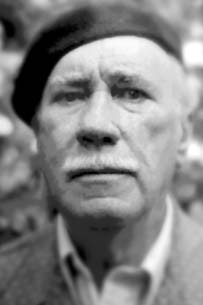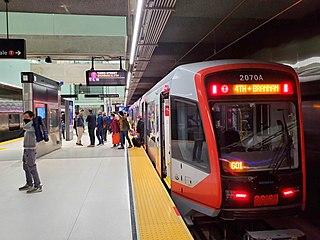
The San Juan Islands is an archipelago in the Pacific Northwest of the United States between the U.S. state of Washington and Vancouver Island, British Columbia, Canada. The San Juan Islands are part of Washington state, and form the core of San Juan County.

Yerba Buena Island sits in San Francisco Bay within the borders of the City and County of San Francisco. The Yerba Buena Tunnel runs through its center and connects the western and eastern spans of the San Francisco–Oakland Bay Bridge, linking the city with Oakland, California. Treasure Island is connected by a causeway to Yerba Buena Island. According to the United States Census Bureau, Yerba Buena Island and Treasure Island together have a land area of 0.901 square miles (2.33 km2) with a total population of 2,500 as of the 2010 census.

The San Francisco–Oakland Bay Bridge, known locally as the Bay Bridge, is a complex of bridges spanning San Francisco Bay in California. As part of Interstate 80 and the direct road between San Francisco and Oakland, it carries about 260,000 vehicles a day on its two decks. It has one of the longest spans in the United States.

Treasure Island is an artificial island in the San Francisco Bay and a neighborhood in the City and County of San Francisco. Built in 1936–37 for the 1939 Golden Gate International Exposition, the island was named by Clyde Milner Vandeburg, part of the Fair's public relation team. Its World's Fair site is a California Historical Landmark. Buildings there have been listed on the National Register of Historic Places, and the historical Naval Station Treasure Island, an auxiliary air facility, are designated in the Geographic Names Information System.

The Battle of Monterey, at Monterey, California, occurred on 7 July 1846, during the Mexican–American War. The United States captured the town unopposed.

Juan Antonio Corretjer Montes was a Puerto Rican poet, journalist and pro-independence political activist opposing United States rule in Puerto Rico.

Linares is a Chilean city and commune located in the Maule Region and lies in the fertile Chilean Central Valley, 303 km (188 mi) south of Santiago and 50 km (31 mi) south of Talca, the regional capital. Linares is the capital city of the province of Linares.

Juan Manuel de Ayala y Aranza was a Spanish naval officer who played a significant role in the European exploration of California, as he and the crew of his ship the San Carlos were the first Europeans known to have entered the San Francisco Bay, having sailed there from the Port of San Blas, Nayarit, Mexico.

Yerbas Buenas is a Chilean town and commune in Linares Province, Maule Region. It lies in the geographical center of the country, on the fertile central plain, some 300 km (186 mi) south of the national capital of Santiago, 50 km (31 mi) south of Talca, the regional capital and 12 km (7 mi) north of Linares, the provincial capital.

The 2006 San Francisco Board of Supervisors elections occurred on November 7, 2006. Five of the eleven seats were contested in this election. Four of the five incumbents ran for reelection, while one sought another elected office.

Pectis is a genus of flowering plants in the family Asteraceae described as a genus by Linnaeus in 1759.

Yerba Buena was the original name of the settlement that later became San Francisco. Located near the northeastern end of the San Francisco Peninsula, between the Presidio of San Francisco and the Mission San Francisco de Asís, it was originally intended as a trading post for ships visiting San Francisco Bay. The settlement was arranged in the Spanish style around a plaza that remains as the present day Portsmouth Square.

The 2002 San Francisco Board of Supervisors elections occurred on November 5, 2002, with runoff elections held on December 10, 2002. Five of the eleven seats were contested in this election. Three incumbents ran for reelection, while two sought another office.

The Yerba Buena Tunnel, also known as the Yerba Buena Island Tunnel, is a highway tunnel in San Francisco, California. It is the part of San Francisco–Oakland Bay Bridge complex that crosses Yerba Buena Island. The Yerba Buena Tunnel carries ten lanes of Interstate 80 (I-80) on two decks, connecting the two component spans of the Bay Bridge, the western suspension span and the eastern self-anchored suspension span. At the opening of the Bay Bridge in 1936, it was the world's largest-bore tunnel.
Pectis elongata, the tropical cinchweed, is a summer blooming annual plant of the genus Pectis, found in the West Indies as well as in South and Central America. Tropical cinchweed is burned as a mosquito repellent.
Pectis linearis, the West Indian cinchweed, is a summer blooming annual plant in the genus Pectis. Its floral region is generally Puerto Rico and the Virgin Islands.
Pectis linifolia, the romero macho, is a summer blooming annual plant in the genus Pectis. It is widespread throughout Mexico, Central America, South America and the West Indies. In the mainland United States, it has been reported only from Arizona and Florida.
Pectis longipes, the longstalk cinchweed, is a summer blooming perennial plant and is a genus of pectis. Its floral region is in the US states of Arizona and New Mexico.
Pectis rusbyi, or Rusby's cinchweed, is a summer blooming annual plant in the genus Pectis. Its floral region is Arizona.

Yerba Buena/Moscone station is an underground Muni Metro light rail station located at 4th Street and Folsom Street in the South of Market (SoMa) district of San Francisco, California. It is named for the adjacent Yerba Buena Gardens and Moscone Convention Center. It opened on November 19, 2022, as part of the Central Subway project. The station is served by the T Third Street line which runs between Chinatown and Sunnydale.













